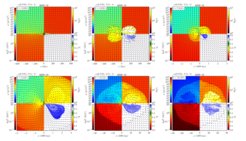What drives supernovalike explosions?
Researchers from the Max Planck Institute for Gravitational Physics in Potsdam and the Universities of Kyoto and Toho have performed a new general-relativistic viscous-radiation hydrodynamics simulation. Their results indicate that rotating stellar collapses of massive stars to a black hole surrounded by a massive torus can be a central engine for high-energy supernovae, so-called hypernovae. For the numerical simulation, the researchers used the new Momiji cluster (5904 cores) as well as the Sakura, Cobra, and Raven clusters at the Max Planck Computing and Data Facility.

Paper abstract
We perform a new general-relativistic viscous-radiation hydrodynamics simulation for supernovalike explosions associated with stellar core collapse of rotating massive stars to a system of a black hole and a massive torus, paying particular attention to large-mass progenitor stars with the zero-age main-sequence mass of MZAMS = 20, 35, and 45M⊙ of Aguilera-Dena et al. [Astrophys. J. 901, 114 (2020) ]. Assuming that a black hole is formed in a short timescale after the onset of the stellar collapse, the new simulations are started from initial data of a spinning black hole and infalling matter that self-consistently satisfy the constraint equations of general relativity. It is found that, with a reasonable size of the viscous parameter, the supernovalike explosion is driven by the viscous heating effect in the torus around the black hole, irrespective of the progenitor mass. The typical explosion energy and ejecta mass for the large-mass cases (MZAMS = 35 and 45M⊙) are ∼1052 erg and ∼5M⊙, respectively, with 56Ni mass larger than 0.15M⊙. These are consistent with the observational data of stripped-envelope and high-energy supernovae such as broad-lined type Ic supernovae. This indicates that rotating stellar collapses of massive stars to a black hole surrounded by a massive torus can be a central engine for high-energy supernovae. By artificially varying the angular velocity of the initial data, we explore the dependence of the explosion energy and ejecta mass on the initial angular momentum and find that the large explosion energy ∼1052 erg and large 56Ni mass ≥ 0.15M⊙ are possible only when a large-mass compact torus with mass ≳1M⊙ is formed.












